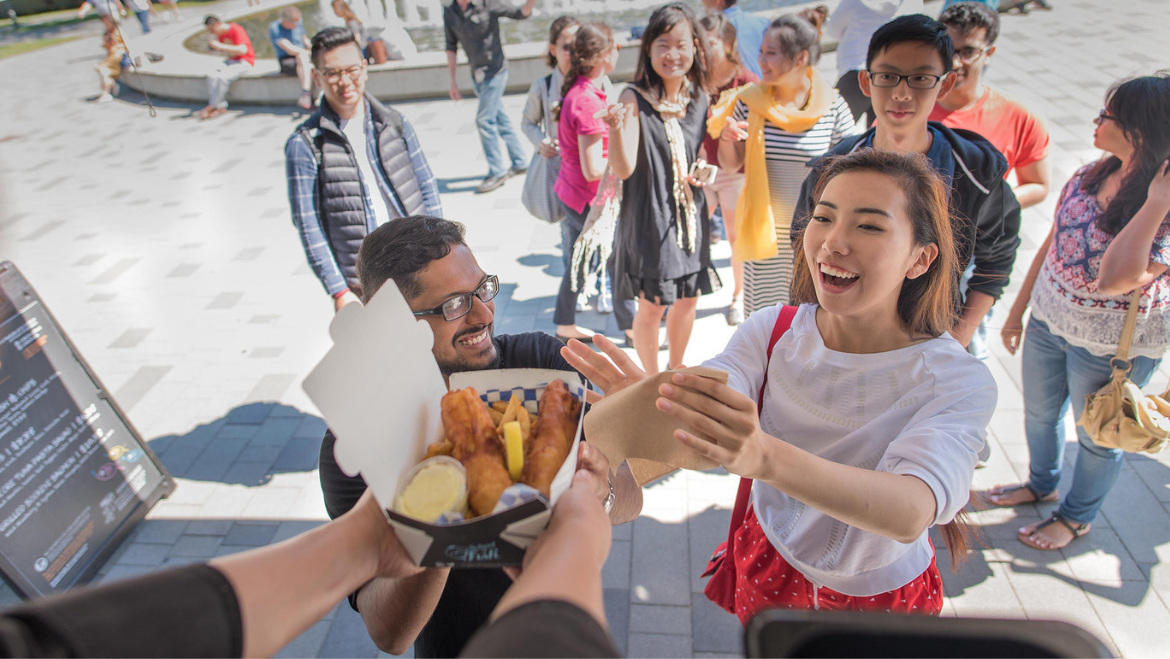

Photo Credit: Paul H. Joseph / UBC Brand & Marketing
How does food promote diversity and inclusivity? Food serves not only as a means of nourishment but also as a way for individuals to engage with and better understand various cultures and communities.
Food has the remarkable ability to bring people together and create a sense of connection. It offers a unique opportunity to learn about different cultures and broaden our understanding of the world. By exploring diverse cuisines, we can gain insights into various societies’ history, traditions, and social structures. For instance, analyzing the ways in which food is prepared and consumed can reveal significant information about gender roles and power dynamics in a given community.
We spoke with faculty and staff from the Faculty of Arts to delve deeper into how food connects us to cultures beyond our own and helps us strengthen our identities.


Dr. Ara Norenzayan
Professor and Distinguished University Scholar at the Department of Psychology
Dr. Norenzayan lives and works on the traditional, ancestral, and unceded territory of the xwməθkwəy̓əm (Musqueam). He is a prolific researcher and teacher in the fields of cultural evolution, social psychology, and the origins of religion. His work examines how cultural diversity shapes the human mind, and he is particularly interested in topics such as cultural and religious diversity, cooperation and conflict, the psychology of metaphysical and supernatural beliefs, human-nature interactions, sacred values, and more.
How has food and culinary arts played a role in shaping cultures?
Since ancient times, food has been a cornerstone of cultures worldwide. It is essential for our survival, which is why preoccupation with food is a human universal that connects us all. To feed our calorie-hungry big brains, our hominid ancestors invented fire and cooking, which outsourced digestion to culture. When you barbeque meat or eggplant, you make them tasty and partially digested before the food enters your mouth. This has been so important for our survival as a species that evolution has modified our bodies to have smaller teeth, weaker chewing muscles, and shorter gastrointestinal tracts than our primate relatives.
“There is more to eating than survival. Eating and drinking are a medium through which we gather, socialize, and create bonds. We celebrate, commemorate, tend to one another, and enact our rituals through food.”
In places such as Vancouver, where the food scene is so diverse, how has the globalization of food affected cultural identities and traditions?
I grew up in Beirut, Lebanon, where an amazingly rich culinary tradition that has been perfected for thousands of years taught me the love of good food. Yet, these were times when globalization had not reached the kitchen table, and I had limited exposure to the various cuisines we take for granted here in Vancouver. I had never had guacamole until I moved to North America!
I have Armenian heritage, which means that I have an arsenal of recipes passed down to me from my mother. I got my love of cooking from her. My two children have had the privilege of enjoying food from everywhere in the world. They don’t find it remarkable at all that in the same week, they could go on a worldwide culinary journey that could include sushi, samosas, tamales, and tabbouleh. Through food, they have come to learn about and celebrate the rich cultural traditions and identities that make Vancouver the wonderfully diverse city that it is.
How does the language used to describe food reflect cultural attitudes and values?
A culture’s food vocabulary is a window into its values and priorities. A typical Italian child can name twenty-two different kinds of pasta, whereas a child in Canada might know three to four different kinds. But it’s not just the vocabulary that matters; it is also the attitudes that are transmitted through language about food.
The cultural psychologist Paul Rozin has found that when French and American research participants are asked what comes to mind when thinking of fried eggs, the French say “breakfast,” Americans say “cholesterol.” The French think of the culinary experience; Americans think of what is entering the bloodstream. Interestingly, this vigilance doesn’t translate into better health. Life expectancy is, in fact, higher in France than in the United States.
How can UBC use food to promote diversity, inclusion, and understanding in our community?
When I first arrived at UBC 22 years ago, the food scene on campus was dismal. We have come a long way and there is now a wide array of eating options, but we can do better. Through food, the university can promote inclusive cultural understanding and a way of life that preserves our planet. UBC is located on traditional Musqueam lands, and there is an opportunity to celebrate the Indigenous culinary ways that have thrived on these lands for thousands of years and to this day.
Another way to do this is by establishing a sustainable food festival that brings together UBC community’s diverse constituents. Finally, we could use more public spaces to gather, eat, and drink together.


Shirley Ting (she/her)
Administrative Coordinator at Asian Canadian and Asian Migration Studies and Centre for Asian Canadian Research and Engagement
Shirley is a second-generation Chinese Canadian who grew up on the ancestral and unceded territories of the hən̓q̓əmin̓əm̓ (Halkomelem) and Sḵwx̱wú7mesh (Squamish) speaking peoples. She recently graduated with a BSc in Global Resource Systems (GRS), specializing in global nutrition and health, and minoring in Asian Canadian and Asian Migration Studies (ACAM). She specializes in community-engaged research for the Initiative for Student Teaching and Research in Chinese Canadian Studies (INSTRCC), and her projects primarily focus on examining the intersections of food, community, identity, and health in the context of BC.
In what ways does food serve as a medium for social and cultural exchange?
For many, food is often the first point of contact in experiencing and learning about the different food cultures that exist between and within communities. Communities aren’t monoliths and that’s reflected in the diversity of food and eating practices that exist. People can have different ways of making the same dish, and we can learn a lot about a particular group or individual’s history and culture by being curious about these differences.For example, my grandma’s Egg Foo Young looks and tastes completely different to what you might find in a restaurant or in somebody else’s home. After asking about her version, I realized that she learned how to make it by picking up different cooking styles as she traveled from Jiangxi, Macau, and Hong Kong. Her way of cooking is informed by her own lived experiences, which is what makes her food so uniquely delicious. There are a lot of stories embedded in the food that we eat.
“If we approach food with curiosity, there is so much potential for cultural exchange and learning– which is one of the many reasons why I love to eat!”
What role can education play in helping people appreciate and respect the cultural significance of food?
Food is universal; everyone eats, and we all have experiences with food that hold cultural and personal significance. Educational programming can highlight these experiences by providing opportunities for reflection and sharing. But it’s important to emphasize that education doesn’t need to be ‘academic’ or take place in a classroom setting. Programming, especially community-engaged programming, is most impactful when we intentionally meet people where they’re at.
For instance, while I was a research assistant at the Initiative for Student Teaching and Research in Chinese Canadian Studies (INSTRCC), our team worked in community gardens across Richmond with Urban Bounty, a local non-profit, and a few gardeners to build community and connections across the city through food-based story-telling. The project was impactful for us and the other people involved because we one, took time to learn about what community members wanted to say and do; two, were intentional in using food as an accessible and inclusive platform for community engagement; and three, our community members already had so many insightful and interesting stories they were excited to tell. There is so much knowledge and expertise outside of UBC, and food is an excellent medium for programming to share these stories.
How can UBC use food to promote diversity, inclusion, and understanding in our community?
If our goal is to promote diversity and inclusion, it isn’t enough to think of food just as refreshment. We need to consider the context in which the food is served: how are we preparing the food? For whom? What types of relationships are being fostered by providing and sharing this meal? And most importantly, in what ways do our actions align with our intentions and values? This is because food is more than just sustenance. Food is community.
UBC can use food to promote diversity and inclusion by learning about who the communities we work with are and honouring the different histories their various food cultures come from. When we share meals with community, it’s also important to recognize our position at UBC and how that relates to those outside the university. By using this approach to food, we can be better positioned to engage and build positive relationships intentionally while being culturally informed. Breaking bread together is an excellent means to building strong relationships, but it’s crucial that we come to the table already having done the work needed to be good hosts.


Dr. Amy Hanser (she/her)
Associate Professor at the Department of Sociology
Dr. Hanser lives and works on the traditional, unceded territory of the Musqueam People. She is a sociologist who has conducted extensive research on various topics such as the sociology of work, gender, consumer culture, markets, and service work in China. She also teaches about economic sociology, food, and consumption. Currently, she is researching the experiences of immigrant Chinese women in Canada during childbirth and postpartum recovery.
How has food and culinary arts played a role in shaping cultures?
There are two ways to think about this question: If we treat culture as a bounded entity (for example, “Canadian culture” or “Chinese culture”), then we can see food as an important component of culture—food practices and traditions help communicate cultural values, reproduce those values over time and across generations, and help bolster a group’s sense of having a distinct identity, different from other groups. In modern times, food has become an important component of (some) national identities, so much so that some governments take actions to protect domestic food industries from foreign competition in an effort to preserve a sense of distinct, national culture.
But if we think about culture as simply a component of social life—distinct from the economic, the political, etc.—then food is an aspect of social life through which cultural beliefs and practices might be expressed. For example, we have ideas about what kinds of food are “good” or “healthy,” and societies usually have ideas about the “food rules” we should follow—what kinds of and how much food we should eat, when we are allowed to break the rules, and so forth. Likewise, there are usually distinctions between “low brow” (unsophisticated) and “high brow” (sophisticated) foods, and historically these distinctions have mapped onto socio-economic hierarchies. For example, gourmet diners are usually people who have accumulated a lot of cultural knowledge about food and have the power to define which foods are worthy of respect, and which are disparaged.
“Ideas about food are integral to conceptions of femininity and masculinity, the division of labor in the family, and even the organization of systems of food production.”
In what ways does food serve as a medium for social and cultural exchange?
Food is an important way that people experience elements of cultures that are not their own, and people who are open to new and novel experiences often seek out opportunities to experience foods associated with other cultures. These experiences enrich our lives, and we should value them! At the same time, eating “someone else’s” food is a relatively superficial way to engage in cultural exchange, and it can result in complicated situations in which cultural outsiders seek out the most “authentic” and “exotic” food experiences for their own entertainment. This is just to say that we should probably be modest about how meaningful a medium food is for cultural understanding and social exchange.
What can we learn about a society’s gender roles and power dynamics from the ways in which food is prepared and consumed?
Food culture—both in terms of abstract ideology and norms and concrete practice—is profoundly gendered. We see this in everything from who prepares food, and where ( for example, women dominate home food preparation and men dominate commercial food preparation) to who eats what, and how much—women tend to be far more restrictive in what they eat, for instance.


Dr. Kelly McCormick (she/her)
Assistant Professor at the Department of History
Dr. McCormick writes, teaches, and lives from the location of a settler living on the unceded traditional territories of the xʷməθkʷəy̓əm (Musqueam), Sḵwx̱wú7mesh (Squamish), and səlilwətaɬ (Tsleil-Waututh) Nations. She acknowledges that they are the rightful inhabitants of the lands and waters that are now called Vancouver, where the University of British Columbia is located. UBC, where she is employed to teach and conduct research, is itself a colonial institution which was founded on stolen land and continues to profit from this land. Dr. McCormick is a modern Japanese culture historian who researches the impact of Japan’s changes on photography and mass media. She also studies photography’s role in state governance, gendering, museum practices, and environmental protests.
In what ways does food serve as a medium for social and cultural exchange?
Different dishes can be examples of the cultural exchange that was necessary to produce them, and it is fascinating to try to trace back their origins. Let’s think about ramen as an example. The ingredients that go into making ramen took centuries to reach Japan, either as foods associated with the spread of Buddhism or as the result of trade, colonialism, and imperialism. Then once something like wheat-based noodles reached Japan, they were innovated upon to change their thickness and texture and many new forms took shape including udon, soba, somen, and ramen noodles. As a dish with Chinese origins that has been built on over time, ramen became something that reflected Japanese history and changing culture.
“Specific dishes are often reflections of changing interactions across cultures rather than an unchanging 'tradition' which is often the argument that is made about them.”
How does the language used to describe food reflect cultural attitudes and values?
Language certainly plays a big role in our relationship to food, but sound and touch also have an important role. In Japan, slurping your ramen noodles to express satisfaction with the flavor-texture combination, for example, is seen as the preferred way to interact with the delicious bowl.
There is a great scene in Itami Juzo’s film, Tampopo (1985) where a group of women at a fancy hotel are being taught food etiquette and told to eat their Italian pasta noodles slowly and quietly. Another diner sitting nearby gleefully slurps up his noodles and the joy he gets from audibly and physically interacting with his food is infectious and before they know it even the teacher is also slurping her noodles.
What can we learn about a society’s gender roles and power dynamics from the ways in which food is prepared and consumed?
We can all think of culinary traditions around the world that value male and female labor in very different ways. In my classes I find it validating to look for historical examples of how these expectations are turned on their head or moments when a food is made into a symbol of something that we are not aware of today. For instance, during the Fifteen Year War (1931-1945) in Japan white rice was given as a provision to the military, reinforcing the idea that white rice was central to Japanese food culture when before many rural communities relied more on millet, barley, and sweet potatoes in their everyday diet. This meant that after the wartime period, the militarist masculinity associated with white rice as a war staple was transformed into middle class desire for eating white rice for three meals a day.
What role can education play in helping people appreciate and respect the cultural significance of food?
As a historian, I am really interested in bringing food history into the classroom to think through the ways that food has been an active agent in history and how it helps us to challenge preconceptions about the way a culture has developed over time.
One example that I have been thinking about recently is konbu – this thick kelp is the staple for all Japanese soup bases and many simmered dishes. For much of history it was also primarily found growing along the coastlines of Ainu Mosir or what is now the northern island of Japan called Hokkaido. Konbu was traded between the Ainu, who are Indigenous to the island and the Japanese for centuries and the desire to control its trade is one of the many reasons that the Japanese used to justify colonizing the island. Most people don’t see this history when they eat miso soup made from konbu, but it is all there.


